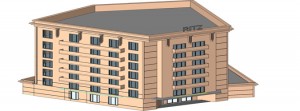The Industrial Revolution, which happened in the latter half of the 18th century, brought about a number of changes in the architectural scenario all over the world.
The world turned greatly towards Greek and Roman forms of architectural design. It was considered fashionable, and rightly so, to borrow from various types of architectural designs. The Greek designs were what dominated the architectural designs that were taken up, right till the 19th century.

Because the Industrial Revolution also saw advancement in technology and manufacturing facilities, it became easier for architects to design new styles of buildings. New architectural designs were incorporated with ease as builders in one geography adopted architectural designs from elsewhere, which enabled greater diversity and cross-polination of ideas from the time of the Industrial Revolution. It was during the Industrial Revolution that the textile industry also boomed. Because of this development, architectural designs introduced fabrics like velvet and silk. This brought about the concept of interiors being incorporated into the architectural designs, making them interestingly different from all the designs known to exist before this era.
Many who have studied architecture would probably agree that because these architectural designs were drawn by the same contributing factors, they seemed to lack imagination and style. However, these architectural designs were practical, lasting, and only got better with other accompanying advancements.
Advancements in the Industrial Revolution also contributed greatly in the evolution of architectural design as we see them today. At the height of the Industrial Revolution, architecture celebrated both the ornamental and the unadorned and embraced mass production in an almost unbelievable display of goods and resources.
The rise of heavy industry generated a multitude of new building materials such as cast iron, steel, and glass, which enabled architects to design structures that were never before possible.
Apart from architectural designs flourishing with respect to housing and commercial buildings, architecture also saw a boom with respect to other forms of infrastructure such as canals, tunnels, bridges and the likes.
The Industrial Revolution brought about a number of changes in the way architecture was perceived post 18th century. Architectural design took a major turn. Access to better resources, more material, better techniques; all were contributing factors to architecture becoming a full-blown and still flourishing industry today.
Many old architectural drawings dating from the Industrial Revolution have still not been converted to CAD. The process of converting legacy drawings into CAD goes by various names: CAD conversion, CAD vectorization, raster to vector conversion, etc.
Many architectural drawings today are as old as the industrial revolution, and are still on the original paper they were printed on. There are several ways to convert them to CAD, including a manual tracing process and the use of auto-vectorization tools. To convert a legacy drawing to CAD free of cost, use our Get-A-Quote form to submit an image of the paper drawing, either a scanned version or simply a photograph. We would be happy to convert one drawing free of cost for you — just use the following discount code: Industrial-Revolution-Free. Alternatively, you can select from a menu of free software tools that can help you with this.
Leave a Reply